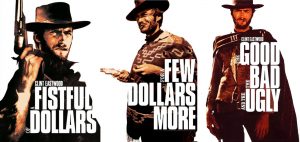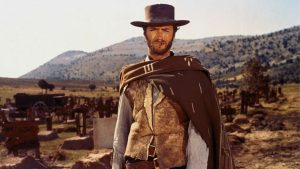The score for Sergio Leone’s 1964 film A Fistful of Dollars, composed in Italy by Ennio Morricone for American movie audiences, ushered in a new style of Western film music by using semi-electric hollow-body guitars and RF condenser microphones to compose a distinct sound. This score helped reinvent the Western itself utilizing whistles and surf-sounding electric guitar riffs to create thinly-textured soundscape that matched the barren scenery of Western film backgrounds and contradicted former film scores that favored large, symphonic, dramatic orchestration.
Throughout this website, you will find evidence to support our claim that Morricone’s score was pioneering and influential.
Below is a copy of the sheet music for the title theme which we will analyze. Its simplicity is important to the distinct sound of the film.
The walking baseline, featuring alternating sixteenth and eighth notes, is steady, but the sixteenth notes create a slightly rushed sound, indicative of anxiety or underlying tension.
About “A Fistful of Dollars”
Director Sergio Leone’s second feature film A Fistful of Dollars was part of the “Spaghetti Western” genre of movies set in the American West but filmed and produced in Italy. “Spaghetti Westerns” were popular with American film audiences, and often starred Hollywood actors who performed in English.
A Fistful of Dollars introduced American film audiences to future Western superstar Clint Eastwood. His character, known as “the stranger” or “the man with no name” is a gun-slinging hero and vigilante who parades through towns settling disputes and defending his honor. This character is the principal role in two more films, creating what is known as the “Dollars Trilogy” or “The Man with No Name Trilogy” and featuring the subsequent films For a Few Dollars More (1965) and The Good, The Bad, and The Ugly (1966).

The story of A Fistful of Dollars revolves around the stranger in San Miguel, Mexico, and his encounters with the rival families: the Rojos and the Baxters. The tall, mysterious, cigar-toting stranger pits the groups against each other, in order to make money off of their conflict. Eastwood’s character rescues a woman, Marisol, from the Baxter family and sets her free, encouraging her to leave town and escape the bloodbath that is to follow. The film ends with a violent shootout, leaving the stranger as the last man standing.
A Fistful of Dollars isn’t just known for Clint Eastwood and its dramatic narrative, but was the center of a controversy around Sergio Leone’s re-making of an Akira Kurosawa film. Audiences were quick to notice the similarities between A Fistful of Dollars and Yojimbo (1961), a movie about samurais and revenge. After the release of Leone’s film, Kurosawa sent him a letter, saying, “I’ve seen your movie. It’s a very good movie. Unfortunately, it’s my movie.” Internationally acclaimed Japanese filmmaker Kurosawa took Leone to court over the rights to his story, and though Leone initially ignored the summons, he eventually settled for $100,000. (Frayling, 2000, 14-16).
Images Courtesy of:
The Story of Zero, WordPress Page
The Forgetful Film Critic
